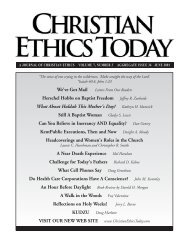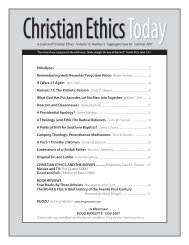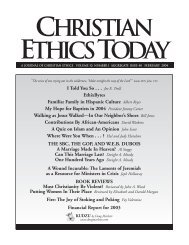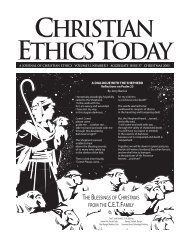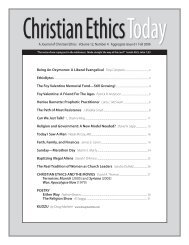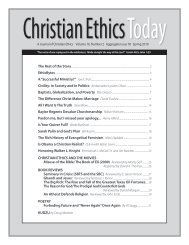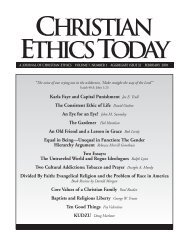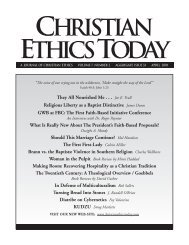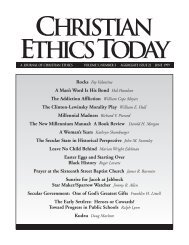Issue 052 PDF Version - Christian Ethics Today
Issue 052 PDF Version - Christian Ethics Today
Issue 052 PDF Version - Christian Ethics Today
You also want an ePaper? Increase the reach of your titles
YUMPU automatically turns print PDFs into web optimized ePapers that Google loves.
off a man’s ear—the one organ that equips the victim to hear<br />
the word of testimony. Rather than simply teach about nonviolence<br />
(as in Matthew) or underline the divine necessity of<br />
his own death (as in John), Jesus heals the ear, thus equipping<br />
the slave anew to hear the gospel. Luke thereby turns the negative<br />
message of Matthew and John—don’t use force and<br />
don’t get in the way of God’s will—into a positive lesson:<br />
when under threat, preach the gospel of the kingdom.<br />
How likely would it be that Luke—or Jesus—would use<br />
“sword” symbolically in this way, and what confidence<br />
might Luke have that his readers would understand the symbolism?<br />
As it turns out, there’s every reason to believe that<br />
“sword” was frequently used in this manner in the NT community<br />
and every reason to argue that later <strong>Christian</strong>s who<br />
took Luke 22:35-38 as a call to bear arms have been just as<br />
thick-headed as Jesus’ disciples before the resurrection.<br />
The first biblical use of “sword” to indicate the word of<br />
God occurs in Isaiah 49:2—“He made my mouth like a<br />
sharp sword.” The early church seized on this metaphor and<br />
used it in no fewer than three strands of the NT. To begin<br />
with, in Ephesians 6:17, Paul frankly equates the term<br />
“sword of the Spirit” with the word of God. The writer to the<br />
Hebrews uses the symbol in a comparative simile: God’s<br />
word is sharper than a sword (Heb 4:12). And John the<br />
Revelator makes the same point imagistically when he portrays<br />
the sword of the triumphant Christ issuing from Jesus’<br />
mouth (1:16; 19:15). Thus, Luke could expect that his readers,<br />
unlike the slow-witted disciples, would get the point (no<br />
pun intended) and would realize that, on the eve of his death,<br />
Jesus continued to advocate non-violence and to urge his followers<br />
to speak the gospel truth as their main strategy when<br />
under attack.<br />
Furthermore, Jesus himself, according to Matthew’s witness,<br />
made this connection between testimony and swords<br />
earlier in his ministry: In Matthew 10:34, Jesus says, “I have<br />
come to bring a sword.” This is a “Q saying” that appears in<br />
Luke (12:51-53) and Matthew, but not in Mark or John. In<br />
Luke’s version the saying makes no references to weaponry,<br />
nor does it deal with witness or preaching. In Matthew’s<br />
Gospel, however, the saying occurs in the middle of a passage<br />
about acknowledging Jesus and spreading the word of the<br />
Kingdom through prophecy. Here again, when Jesus associates<br />
himself with swords, he draws an immediate connection<br />
between swords and the word of testimony.<br />
What then do we conclude? Faithful followers of Jesus<br />
Christ anticipate conflict including conflict that will maim<br />
or kill them. But following the teachings of their Lord as well<br />
as his example, faithful <strong>Christian</strong>s eschew the use of violence<br />
and instead go on the attack wielding the sword of the spirit,<br />
the word of testimony. ■<br />
12 • CHRISTMAS 2004 • CHRISTIAN ETHICS TODAY<br />
SPECIAL OFFER<br />
Special Christmas Gift<br />
Sent To Every Subscriber<br />
In December<br />
Whatsoever Things Are Lovely<br />
Foy Valentine’s new book is a<br />
compilation of 35 essays written for<br />
<strong>Christian</strong> <strong>Ethics</strong> <strong>Today</strong>. This hardback<br />
and handsomely printed book is being<br />
sent to each of our 3600 subscribers.<br />
The dust jacket of this 160-page treasure<br />
features scenic views of Wheeler Peak<br />
and Foy’s family in their classic WW II<br />
Jeep near his Red River cabin.<br />
Thanks to a benefactor we are able to<br />
send this book as our “Thank You” to<br />
our subscribers for their support and<br />
encouragement over the years. We<br />
intentionally published several thousand<br />
extra copies for our readers and for<br />
future promotions.<br />
Extra Copies Of<br />
The Book Are Available<br />
While They Last<br />
Many of you will want extra copies to<br />
share with your family and with friends.<br />
Once you see the book, you probably<br />
will want to order several as gifts. The<br />
Journal will mail extra books, postage<br />
paid, according to these arrangements:<br />
• 5 Copies For Contributions of $50<br />
• 12 Copies For Contributions of $100<br />
• 30 Copies for Contributions of $250<br />
As the Journal is totally supported by<br />
your gifts, we deeply appreciate every<br />
contribution. Call or email us if you<br />
have questions.



